As we were in no hurry to reach our hotel in the principality of Andorra, nestled between Spain and France, we decided to detour to the small town of Villajuiga in the far northeast corner of Spain before stopping at the Sant Pere de Rodes monastery complex on Serra de Rodes, a mountain range right further north. In one of the town squares, Placa de la Sardana, was a sculpture of the Catalunya dance known as the Sardana, a dance unique to the region in Spain.
What a difference a day made in terms of the weather - the day before, we'd had lots of rain and extremely fierce winds when we visited nearby Cap de Creus National Park. Today, the sun shone and we had clear views on both sides of the mountain pass on the drive to the religious complex.
Views of El Port de la Selva in the distance:
The church lost its status as a parish church in the 16th century and was converted into the St. Helena Chapel where services were held until the end of the 19th century.
A view of Church Square with the Bell Tower and the cemetery behind the church overlooking the sea.
By late morning, we were back on the road heading toward Andorra. The scenery was spectacular and the back country roads between the small towns were in great condition.
As we drove northwest toward the Spanish Pyrenees, we could see snow atop the mountains and also snowy pastures. For quite a while, I'd been worried about the drive for today and the next couple of days, knowing we'd likely be seeing snowy roads in the Pyrenees and wondering if we had the proper clothes, let alone an ice scraper and snow brush for the car should we need it. But we lucked out as there had been a major snowstorm just the day before and the warm temperatures had since melted much of the snow on the roads.
Chairlifts were running at the Soldeu Ski Resort because of the freshly fallen snow. I don't know whether they normally have this much snow by the beginning of November or whether this was an aberration. It was hard to come up with a more picturesque spot with the bright blue sky and brand new powdery snow.
As we drove slowly along the stunning mountain valley road, we kept seeing and hearing the constant tinkling of cow bells as well as bells on horses. It was as picture perfect a sight as you can imagine, like a scene straight out of Heidi but transported to tiny Andorra from Switzerland!
We soon realized that there must be some strong architectural rules in place in Andorra because virtually all buildings we saw were built with almost identical colors and styles of brick. I loved the way their buildings blended in with the surroundings, but the rebel in me would have liked to see some more variation than what we saw.
Views of El Port de la Selva in the distance:
Yesterday was a white knuckle drive on the very windy mountain pass for Steven, but today it was great seeing exactly where we'd just come from and where we were driving to.
The wonderful weather made us count our blessings as we enjoyed our last views of the Mediterranean.
The Sant Pere de Rodes religious complex was made up of the town of the same name, Verdera Castle and the monastery itself. It was founded in the late 9th century during the expansion of the Benedictine monastery order in the Catalunya counties promoted by the Frankish monarchy.
Before the monastery was the Pilgrims' House.
Between the 10th and 14th centuries, Sant Pere de Rodes became the most important abbey in the county of Empuries because of the protection of the counts and its prestige as a place of pilgrimage. In 1789, after a lengthy decline, the Benedictine community abandoned the abbey. Its art was looted and it fell into ruin. I read the monastery was still one of Catalunya's landmarks for its historic and artistic legacy.
We decided to forego touring the monastery, which had been built in terraces in order to adapt to the terrain, and just hike above it to get better views.
The sign indicated this was the Abbot's House.
Far below was Villajuiga where we had just been.
The medieval town and church of Sant Creu de Rodes were built on a small hill very close to the monastery. The church was built in the 10th century making use of an old watchtower which later became a bell tower. From the 12th century, over the graveyard that surrounded the parish church, the houses were gradually built, as well as the gateway or road into the town. Through the gateway passed all the roads that led to Sant Pere Monastery.
We walked through the impressive gateway to enter the ruins of the old town and see the church closer up.
The greatest time of prosperity for the town was between the 13th and 14th centuries when some of the houses were extended and refurbished and districts were built outside the walls. The 15th century marked the beginning of the decline and gradual abandonment by the inhabitants.
The community had been prosperous with large homes - between 750 and 1,000 feet - based around the church square. The homes had two floors, tiled roofs and often a courtyard, a garden or a farmyard.
It was hard to imagine from the ruins we saw that the town had been so prosperous with fairs and markets and where innkeepers, tailors, bakers, cobblers, and blacksmiths among others offered their services not only to the town's residents, but especially to the pilgrims who flocked to the monastery.
As we drove northwest toward the Spanish Pyrenees, we could see snow atop the mountains and also snowy pastures. For quite a while, I'd been worried about the drive for today and the next couple of days, knowing we'd likely be seeing snowy roads in the Pyrenees and wondering if we had the proper clothes, let alone an ice scraper and snow brush for the car should we need it. But we lucked out as there had been a major snowstorm just the day before and the warm temperatures had since melted much of the snow on the roads.
By the community of Espinosa it was great fun seeing cattle with bells around their necks in the snowy fields beside the road.
The small town of Toses looked especially appealing but we didn't have time to stop and look at it more closely because of our unanticipated detour to Sant Pere de Rodes complex.
Since the roads were just slushy as opposed to icy, both of us enjoyed the newly fallen snow and the winter wonderland around La Cerdanya in the Pyrenees.
We soon saw several trees down in the road and thought that was likely due to the same heavy storm we'd experienced in Costa Brava. The storm, at these far higher altitudes, had of course resulted in snow and not just the rain we'd had.
I bet ski enthusiasts must have been happy as we saw some ski resorts open. I loved seeing the snowman roundabout at La Molina ski resort but just hoped it wouldn't snow for the next couple of days as we hadn't had room to bring winter clothing or boots.
We only realized we'd crossed over into France because we began seeing different road signs. There hadn't been any border crossing at all, nor any signs welcoming people to France!
Even though we were in France, we still noticed a lot of Catalunya flags. Clearly, the separatist movement was also strong in this area of southeast France.
We didn't have time to stop but the medieval stone church in the village of Porta looked so inviting.
As we drove through the really long Puymorens Tunnel, we both wondered how long in fact it was. I just googled it and learned it was almost three and a half miles long which doesn't sound like much after looking at a list of the world's largest road tunnels! The cost was about $9.
The French Pyrenees:
We stopped to get gas and were aghast at having to pay the equivalent of $5.50 a gallon to fill up our small car!
About an hour later we crossed over into Andorra which we knew after seeing this Andorra sign with the European Union colors. Almost immediately, we began seeing extraordinarily long lineups at gas stations and realized, to our chagrin, gas was two bucks a gallon cheaper. That hurt!
The Andorran Pyrenees:
Chairlifts were running at the Soldeu Ski Resort because of the freshly fallen snow. I don't know whether they normally have this much snow by the beginning of November or whether this was an aberration. It was hard to come up with a more picturesque spot with the bright blue sky and brand new powdery snow.
Instead of heading directly to our hotel in Arinsal, outside of Andorra's capital of Andorra La Vella, we drove along the very narrow mountain lane in the community of Vall d'Incles.
As we drove slowly along the stunning mountain valley road, we kept seeing and hearing the constant tinkling of cow bells as well as bells on horses. It was as picture perfect a sight as you can imagine, like a scene straight out of Heidi but transported to tiny Andorra from Switzerland!
It looked like the ski resorts close by also had a good amount of snow. I knew a lot of French and British people come to Andorra to ski.
We soon realized that there must be some strong architectural rules in place in Andorra because virtually all buildings we saw were built with almost identical colors and styles of brick. I loved the way their buildings blended in with the surroundings, but the rebel in me would have liked to see some more variation than what we saw.
I don't know what the small stone structures were in the fields as they appeared to be too small for homes. Perhaps they were grain storage areas.
Our hope had been to hike or walk along this mountain road that afternoon but we ran out of time unfortunately. I was just thankful we had been able to drive along it because it's closed off to all cars from June to September in the height of the tourist season.
Even if you've been to Europe, I doubt you've seen a license plate with Andorra tags. We certainly never had, that's for sure,
The very picturesque Sant Joan de Caselles Church on the outskirts of Canillo was also built of Andorran stone. It looked identical to all the other churches we'd seen, so we'd never have known it had been built in the 12th century. It was closed when we stopped by, but still we could feel the quietness and the intimacy of this ancient place.
The Romanesque church was one of many in Andorra built for a very small congregation. It was amazing to think how something so beautiful had lasted all this time. Clearly it was still a place of religious significance to the locals.
One of the roundabouts near Arinsal that caught my attention:
There was no snow in the capital of Andorra La Vella, or luckily further north toward Arinsal where we were staying for a couple of nights.
Next post: Hiking at Arcalis, the Andorra Parliament & more!
Posted on December 11th, 2018, from Coimbra, Portugal.









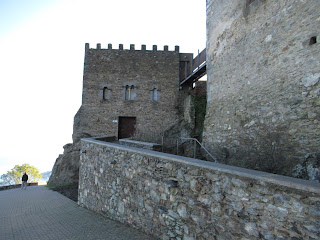




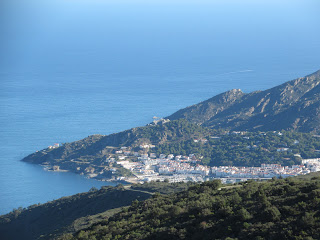






















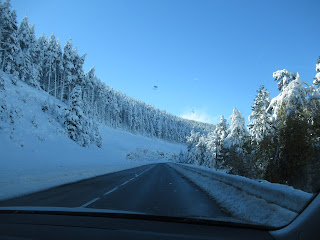











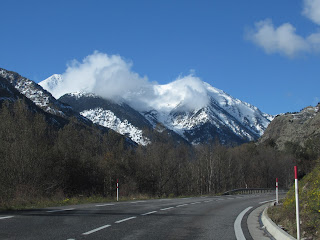














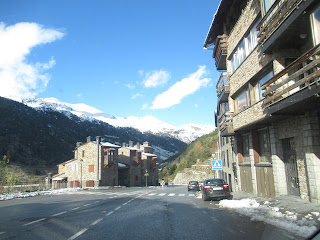





















LOVE the "belled" cattle, the blue skies, the majestic snow covered Pyrenees , the ski resorts and your two wonderful smiling faces!
ReplyDeleteSp glad you also appreciated from afar the 'belled' cattle and the bright blue skies and the snow-covered Pyrenees, Lina. It was all so unbelievably gorgeous!
ReplyDelete